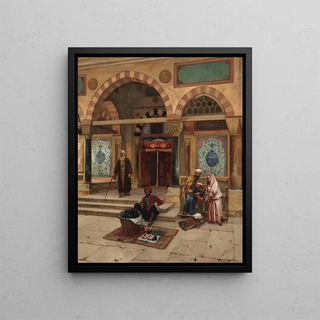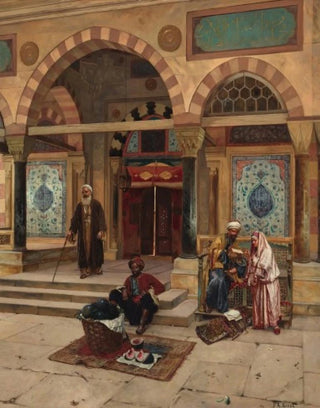Art print | Outside the mosque - Rudolf Ernst


View from behind

Frame (optional)
In the world of art, some works manage to capture the essence of a place, a culture, or a time with such intensity that they become open windows into distant realities. The art print À l'extérieur de la mosquée - Rudolf Ernst is a perfect example. This painting, which immerses us in the vibrant atmosphere of an oriental mosque, evokes a sensory journey into a world rich in colors and traditions. By inviting us to contemplate the daily life of a sacred site, Rudolf Ernst offers a poetic vision where majestic architecture and human life intertwine harmoniously. The piece stands out not only for its composition but also for the way it transports us beyond mere observation, awakening an insatiable curiosity for the Orient.
Style and uniqueness of the work
Rudolf Ernst's work is characterized by a style that combines realism and idealization, creating an almost dreamlike atmosphere. The light, omnipresent, plays a fundamental role in staging the mosque, illuminating architectural details with remarkable delicacy. Warm and golden colors, typical of oriental art, give the scene a warmth and depth that captivate the viewer. Ernst also masters the art of perspective, providing an impression of depth that makes the space almost tangible. The characters, dressed in traditional costumes, add a human dimension to this composition, embodying the life pulsating around this place of worship. Every element, from the decor to the expressions, is carefully thought out to create visual harmony, inviting the viewer to immerse themselves in this vibrant and lively scene.
The artist and his influence
Rudolf Ernst, an Austrian-born painter, is recognized for his ability to translate the Orient through his Western gaze. His fascination with Eastern cultures led him to travel through countries such as Morocco and Egypt, where he drew inspiration for his works. Influenced by the masters of the 19th century, Ernst developed a unique style that combines technical precision and artistic sensitivity. His paintings, often imbued with a romantic atmosphere, bear witness

Matte finish

View from behind

Frame (optional)
In the world of art, some works manage to capture the essence of a place, a culture, or a time with such intensity that they become open windows into distant realities. The art print À l'extérieur de la mosquée - Rudolf Ernst is a perfect example. This painting, which immerses us in the vibrant atmosphere of an oriental mosque, evokes a sensory journey into a world rich in colors and traditions. By inviting us to contemplate the daily life of a sacred site, Rudolf Ernst offers a poetic vision where majestic architecture and human life intertwine harmoniously. The piece stands out not only for its composition but also for the way it transports us beyond mere observation, awakening an insatiable curiosity for the Orient.
Style and uniqueness of the work
Rudolf Ernst's work is characterized by a style that combines realism and idealization, creating an almost dreamlike atmosphere. The light, omnipresent, plays a fundamental role in staging the mosque, illuminating architectural details with remarkable delicacy. Warm and golden colors, typical of oriental art, give the scene a warmth and depth that captivate the viewer. Ernst also masters the art of perspective, providing an impression of depth that makes the space almost tangible. The characters, dressed in traditional costumes, add a human dimension to this composition, embodying the life pulsating around this place of worship. Every element, from the decor to the expressions, is carefully thought out to create visual harmony, inviting the viewer to immerse themselves in this vibrant and lively scene.
The artist and his influence
Rudolf Ernst, an Austrian-born painter, is recognized for his ability to translate the Orient through his Western gaze. His fascination with Eastern cultures led him to travel through countries such as Morocco and Egypt, where he drew inspiration for his works. Influenced by the masters of the 19th century, Ernst developed a unique style that combines technical precision and artistic sensitivity. His paintings, often imbued with a romantic atmosphere, bear witness






